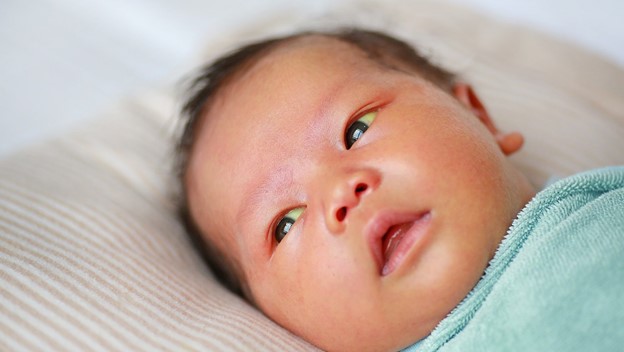Why Does My Baby Look Yellow?
More than half of full‑term infants show some degree of physiologic jaundice in their first week. When red blood cells break down, they release bilirubin, a yellow pigment processed by the liver. Because newborn livers are still ramping up enzyme production, bilirubin can temporarily outpace clearance and tint the skin and eyes. The coloration typically peaks on day three or four, then fades as liver pathways mature.
For a quick visual, the American Academy of Pediatrics offers a parent‑friendly bilirubin chart (AAP jaundice overview) that shows expected timing and shades.
Bilirubin Basics
| Age (Hours) | Bilirubin Risk Zone¹ | Action Plan |
| < 24 h | Any value ≥ 6 mg/dL | Immediate pediatric call |
| 24–48 h | Low < 8 · Medium 8–11.9 · High ≥ 12 mg/dL | Consider lab recheck |
| 49–96 h | Low < 10 · Medium 10–17.9 · High ≥ 18 mg/dL | Possible phototherapy |
| > 96 h | Low < 12 · Medium 12–19.9 · High ≥ 20 mg/dL | Urgent treatment |
¹Adapted from the Bhutani Nomogram, an evidence‑based tool we use in clinic.
Spotting Newborn Jaundice Signs at Home
- Skin Color: Press a fingertip on the forehead or chest; yellow blanching that returns quickly is a tell‑tale sign.
- Eye Sclera: White parts of the eyes turning yellow often indicate rising bilirubin.
- Muscle Tone & Sleepiness: Excess bilirubin can cross the blood–brain barrier, causing lethargy.
- Feeding Difficulty: Poor latch or short feeds reduce stool output—stool helps clear bilirubin through the gut.
Rule of thumb: Yellowing that moves below the belly button before day five deserves a bilirubin check.
Risk Factors That Raise an Orange Flag
| Factor | Why It Matters |
| Prematurity (< 37 weeks) | Liver enzymes less developed |
| Bruising or cephalohematoma | Extra blood breakdown boosts pigment |
| Breastfeeding challenges | Inadequate intake slows bilirubin exit |
| RH or ABO incompatibility | Maternal antibodies burst red cells |
| Family history of glucose‑6‑phosphate dehydrogenase (G6PD) deficiency | Red‑cell fragility raises bilirubin load |
Discuss any of these during your first well‑baby visit so we can schedule timely follow‑up.
Phototherapy: How Blue Lights Work
When bilirubin absorbs blue‑green wavelengths (460–490 nm), it changes into water‑soluble isomers that exit via urine and stool without extra liver processing. A baby wears only a diaper and eye shields under the lamp; feeds continue on schedule. Most healthy newborns see levels drop by 30–40 percent within 24 hours. For more, read the Stanford Children’s Health phototherapy guide.
Feeding Tips to Flush Bilirubin
Breastfed Babies
- Aim for 8–12 feeds in 24 hours.
- Listen for audible swallows; unlatch and relatch if milk transfer stalls.
- Hand‑express a few drops onto dark nipples to help baby find the target faster at night.
Formula‑Fed Babies
- Offer 1.5–2 oz (45–60 ml) every three hours in the first week.
- Keep bottles at body temperature; warm liquid encourages larger, more effective gulps.
A 2024 meta‑analysis in Pediatrics showed that babies hitting 180 ml/kg of daily intake cleared mild jaundice without hospital readmission 90 percent of the time.²
When Bilirubin Becomes Risky
Levels above 20 mg/dL (or > 15 mg/dL in preemies) risk kernicterus, a rare but serious brain injury. Signs include high‑pitched crying, arching, and poor suck. Immediate hospital‑grade phototherapy—or in severe cases, an exchange transfusion—prevents lifelong motor and hearing problems.
At‑Home Jaundice Management Checklist
- Measure diaper output—6+ wet and 3–4 yellow seedy stools daily by day five.
- Expose baby to indirect sunlight near a bright window for 10 minutes, twice daily (eyes shielded).
- Keep a bilirubin log (values, dates, treatment) to share at check‑ups.
- Arrange a follow‑up visit within 24–48 hours after hospital discharge if jaundice appeared before going home.
Our Newborn Visits page outlines the bilirubin testing schedule we follow up to two weeks of age.
Myth‑Busting Corner
Myth 1: “Supplement water between feeds to dilute bilirubin.”
Reality: Water displaces nutrient‑rich milk and can cause hyponatremia; stick to breast milk or formula.
Myth 2: “Switching sides early keeps baby awake and feeding longer.”
Reality: Let baby drain the first breast to access fattier hindmilk; richer calories speed bilirubin clearance.
Myth 3: “A little sunlight through the car window fixes jaundice.”
Reality: Glass filters helpful UVB rays; therapeutic light needs specific spectrum and intensity.
Sample Q&A With Our Lactation Nurse
Parent: “My baby is 36 hours old and looks yellow. Should we panic?”
Nurse: “Most likely normal—but we’ll schedule a transcutaneous bilirubin scan. If high, we’ll order a simple heel‑stick blood test.”
Quick bedside scans avoid unnecessary lab draws; results guide whether home phototherapy or in‑hospital lamps are needed.
Trusted External Resources
- Bilirubin Levels Explained – Mayo Clinic breakdown of tests and treatments.
- Understanding Newborn Jaundice – March of Dimes parent factsheet.
Both open in new tabs and provide physician‑vetted, easy‑to‑digest information.
Bright Beginnings, Bright Skin
With frequent feeds, watchful eyes, and quick bilirubin checks, most jaundice fades within a week—no lasting harm done. Early follow‑ups ensure levels stay safely below the danger zone.
Peace of Mind in One Appointment
Newborn checks include bilirubin test—book your visit and keep yellow worries in the clear.







